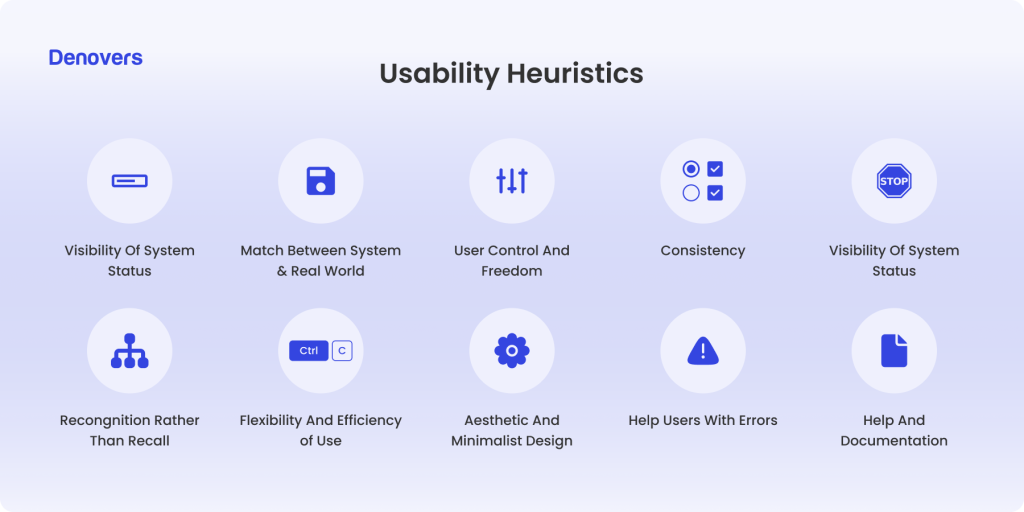Imagine coming across a product that has amazing design but poor usability. What would you do? Abandon it right because when the interface is so unusable, what use would be the design? The user experience of a platform is the biggest factor when it comes to extracting ROI. Not only do products with exceptional usability elevate the user experience, but they also contribute to product quality. Considering its excessive benefits, it is essential to inspect its usability from time to time. This is where “Heuristic Evaluation in UX design” comes in.
Wondering what’s heuristics evaluation? Keep reading this article as we are about to share this UX assessment method in detail and also shed light on how to conduct it successfully.
Let’s get started.
Avail Your
Free UX Audit Checklist
Ultimate UX Audit Checklist compiled by Top-rated UI/UX design professionals on how to make your SaaS app amazing.
What is a Heuristic Evaluation in UX Design?

Heuristic evaluation is a process to find common usability issues that disrupt the smooth and effective flow of user experience. These issues are then addressed to improve the digital product by improving the user experience and satisfaction.
Heuristic usability evaluation is conducted by a team of UX experts who test the digital product against a list of heuristics principles. This way, the platform’s interface can be cross-checked to identify where the product is not following the principles. There are several renowned principles for usability tests, like
- Eight Golden Rules of Interface Design by Ben Shneiderman
- 10 Cognitive Engineering Principles by Jill Gerhardt-Powals
- About Face 2.0: The Essentials of Interaction Design by Alan Cooper
- Six Design Principles for Usability by Don Norman
- 20 Usability Heuristics by Susan Weinschenk and Dean Barker
- 247 Web Usability Guidelines by Dr David Travis
However, the most comprehensive and effective one is the Heuristics for User Interface Design by Jacob Nielsen in 1995. Let’s have a look at them
Although a single designer or expert is enough to conduct a heuristic evaluation in UX design and notice the issues with the user interface, it is better to get a group of evaluators. This way, you will get a comprehensive heuristics analysis as they will flag maximum usability problems. The UX designers evaluate each usability issue and give them a severity rating so that they can start working on the most crucial one to give the product a major boost after the heuristic evaluation.
Why Should You Do Heuristic Evaluation in UX Design?

There are several reasons to perform a heuristic test. Let’s have a look at some of them.
| Reasons | Description |
| Enhanced usability | Heuristic testing improves usability by systematically identifying and rectifying design elements that align with established usability principles, resulting in a more user-friendly interface. |
| Efficiency | The efficiency of a system is optimized as evaluators pinpoint and address design aspects that may impede users’ task completion, streamlining the overall user experience. |
| Flexibility | Heuristic evaluation enhances flexibility by recognizing and addressing design constraints, allowing for adaptability and responsiveness to diverse user needs and preferences. |
| User satisfaction | By focusing on the heuristic principle, evaluation enhances user satisfaction by eliminating potential friction points and ensuring that the interface aligns with user expectations, preferences, and overall satisfaction. |
| Discoverability | It enhances discoverability by identifying and refining navigational elements, making it easier for users to locate and interact with features, thus improving the overall user experience. |
| Memorability | Through heuristic evaluation, the interface is optimized for memorability by addressing design elements that aid users in recalling and effectively utilizing the system after initial interactions. |
| Learnability | Evaluators focus on improving learnability by identifying and refining aspects of the interface that contribute to a user-friendly onboarding experience, reducing the time and effort required for users to become proficient with the system. |
| Cheaper and faster | Heuristic evaluation proves cost-effective and expeditious compared to extensive user testing, allowing for rapid feedback and iteration in the design process. |
When Do You Need Heuristic Testing?

There is no set time to conduct a heuristic evaluation in UX design. Think of it like a handy tool that can be used at different stages of designing stuff. But be smart about it; doing it too early isn’t helpful. For new things, it’s usually best to slap on a heuristic analysis after you’ve done the basic sketches and prototypes but before you start making things look pretty. Waiting too long to do this can make fixing things a pain and expensive. If you’ve got an existing thing that people struggle with, it’s a good move to run a heuristic analysis on it before giving it a makeover. This helps find and fix usability problems, making the whole user experience smoother.
What is the Outcome of Heuristic Evaluation in UX Design?

Similar to various usability tests or inspection approaches, the customary outcome of a heuristic evaluation is a comprehensive report. This report not only pinpoints usability issues but also categorizes them based on their severity, ranging from critical to minor concerns. Interestingly, a heuristic test report usually refrains from providing explicit solutions. Luckily, many usability issues come with relatively straightforward fixes. Once identified, the design team can promptly initiate the process of addressing and refining the identified concerns.
How do you do a Heuristic Evaluation in UX Design?

Conducting heuristic evaluation in UX design is not as challenging as it seems. Following the right set of steps can help you achieve a productive outcome. Here are some of the basic steps to conduct an effective heuristic analysis
Step 1: Define the Goal

Defining the goal is super important when it comes to conducting a heuristic evaluation. This is necessary so that the heuristic test is conducted in a specific area of the site where it is required and not the entire site, as this could take a very long time and, therefore, become too expensive. This might be hard for those who have small sites and tight budgets.
As a result, you should set parameters to test only the essential areas of the site. For instance, you may have the time and resources only to test specific user interfaces like shopping carts, subscription panels, checkout, landing pages, product description pages, functionalities, search and browse, and log in/register.
Step 2: Know the user

If you want to ensure that the findings of the heuristic test are aligned with the users, it is important to know the users inside out. While conducting a heuristic evaluation in UX design, it is necessary to set various user personas to know the needs of your target audience. Make sure to know if the users are beginners or experts and what demography they belong to.
For instance, while heuristics were originally intended to serve as universal usability standards, it may be essential to prioritize accessibility for an older demographic or to consider the needs of diverse, multicultural audiences.
Step 3: Understand business goals

Understanding business goals is crucial when conducting heuristic testing as it ensures that the evaluation aligns with the overarching objectives of the organization. Heuristic analysis involves assessing a system’s usability based on predefined principles or rules and conducting these evaluations according to the specific goals of the business, ensuring that the focus is on areas that directly impact the success of the company. By aligning heuristic testing with business goals, organizations can identify usability issues that may hinder the achievement of strategic objectives. This results in more targeted and impactful improvements in user experience that contribute to overall business success.
Step 4: Decide on which set of heuristics and reporting tools to use

Once the goal and target users are decided, it is now time to decide which set of heuristics to use so that the designers and experts can conduct the UX assessment. The heuristic evaluation in UX design is done by checking whether the interface and its functionalities are according to the given principles. It is essential to follow the guidelines of a specific set of heuristics so that each UX assessment expert can do their evaluation and come on the same page to avoid confusion. If all of them end up using different sets of heuristics, the result will be inconsistent and ineffective due to conflicting reports.
Moreover, it is necessary to decide what the evaluation plan will be before time so that a system and format can be decided along with the necessary tools. There are several options like Slides, Sheets, Google Docs, or any other relevant reporting tool that is accessible to everyone.
Step 5: Evaluate and identify usability issues

During the heuristic evaluation in UX design, every expert will evaluate the user interface on their own to ensure that the inspection is unbiased and independent. Once the evaluations are completed, they can be gathered and aggregated. Appointing an observer is a good idea as they add value to the evaluation process. You might feel that this is an extra expense, but it’s totally worth it. From helping evaluators with limited domain experience to guiding the session when limited functionality prototypes are being evaluated, the observer can offer several benefits in heuristic analysis. They also take notes in every session to consolidate the entire evaluation in one report at the end.
Make the findings provide precise descriptions of the identified issues to guide the team towards effective design solutions. Ambiguous notes like “this design will impact the registration process negatively” lack productivity and add no value to the improvement process. It is essential to ensure that notes are specific, clearly articulating the violated heuristic. For instance: “The registration process exhibits a confusing and inconsistent UI layout, violating the principles of user control, feedback, and consistency (#1, #20, and #16, respectively).” This level of specificity not only enhances the clarity of issues but also facilitates targeted and informed corrective actions.
Step 6: Collect and analyze

Once the entire heuristic evaluation is completed, it is time to collect the data for effective analysis. The observer gathers all the data to review it. After analysis, they eliminate the unnecessary and duplicate findings to make data interpretation easy and effective. This is followed by combining the heuristic data reports in a table so that the severity ratings of various usability issues can be seen. This will help the design team to prioritize their various tasks accordingly.
Step 7: Present the data

Now, it is time to present the data in a table that lists not only the identified usability problems but also their severity and which heuristic guideline they are violating. For instance, the screen mentioned earlier highlights that employing low-contrast text in the user interface goes against the principles of “visibility” and “discoverability.”
Let us Conduct a Heuristic Evaluation in UX Design for you.
Still confused about how to conduct Heuristic evaluation in UX design? Let Denovers do it for you! We are home to several skilled and experienced design experts and evaluators who will efficiently examine and assess your website’s interfaces to even the minutest usability issues. Our proficient team will help list down all the UI problems existing in your digital platforms, and our top-tier designers will also assist you in solving all the issues.
Do you want your users to break their backs while using your platform or enjoy a smooth experience? The choice is yours!
In a Nutshell
Conduct a heuristic evaluation in UX design, and you will be surprised at the number of usability issues that will come up. Therefore, it is paramount to regularly do usability heuristic evaluations to identify and sort out any usability issues for the smooth and efficient working of your digital products in the competitive market. Moreover, don’t let the drill stop here. Start implementing user-testing and cognitive walkthroughs to ensure your product is up to the mark. It all boils down to developing a strong product and not one that is destined to fail.
FAQs
What is an example of a Heuristic evaluation process?
An example of a heuristic evaluation process is assessing the usability of a website by applying Jakob Nielsen’s heuristics, which include principles such as visibility of system status, a match between the system and the real world, and user control and freedom. In this process, usability experts systematically examine the interface, identifying potential issues and deviations from these established heuristics. Through a thorough evaluation, the experts can provide valuable insights into user experience, helping designers and developers enhance the overall usability and effectiveness of the website.
Is usability testing a Heuristic evaluation?
Usability testing and heuristic evaluation are different methods within the realm of user experience evaluation. Usability testing involves observing users as they interact with a product to identify practical issues and gather insights into user behavior. It often employs real users in real or simulated environments. On the other hand, heuristic evaluation is a more structured, expert-driven approach where evaluators assess a product based on a set of predefined heuristics or principles, identifying potential usability problems. While both methods aim to improve usability, usability testing relies on user feedback and behavior, while heuristic evaluation relies on expert evaluation against established principles.
How do you evaluate a UX design?
Evaluating a UX design involves a dynamic approach aimed at assessing the overall user experience. Key factors include usability testing, where real users interact with the design to identify potential issues and gather feedback. Additionally, heuristic evaluations based on established usability principles provide a systematic assessment by experts in the field. User feedback through surveys, interviews, and analytics helps gauge user satisfaction and understand their needs. A comprehensive evaluation considers factors such as accessibility, visual design, and overall functionality to ensure a seamless and enjoyable user experience. Regular iterations and improvements based on these evaluations contribute to the ongoing refinement of the UX design.
What is the main purpose of the heuristic evaluation method?
The main purpose of the heuristic evaluation method is to systematically assess and identify usability issues in a user interface by using a set of predefined heuristics or guidelines. This method involves expert evaluators examining a system or product against established principles to uncover potential design flaws and usability problems. By conducting a heuristic evaluation, designers and developers can gain valuable insights into the user experience, prioritize areas for improvement, and ultimately enhance the overall usability and effectiveness of the interface.








